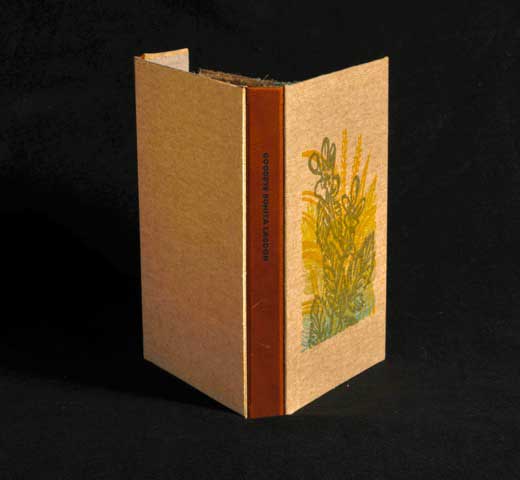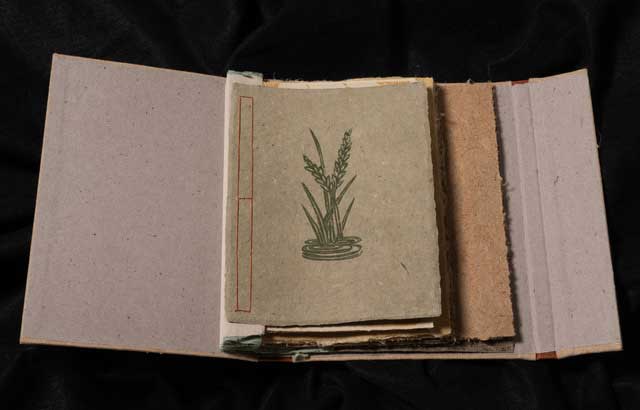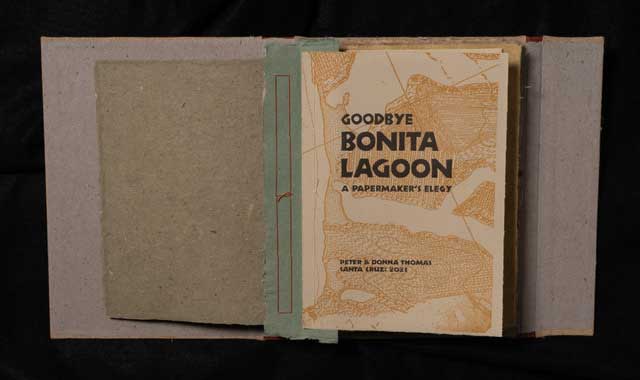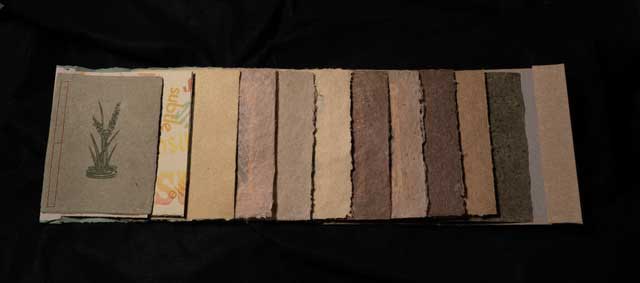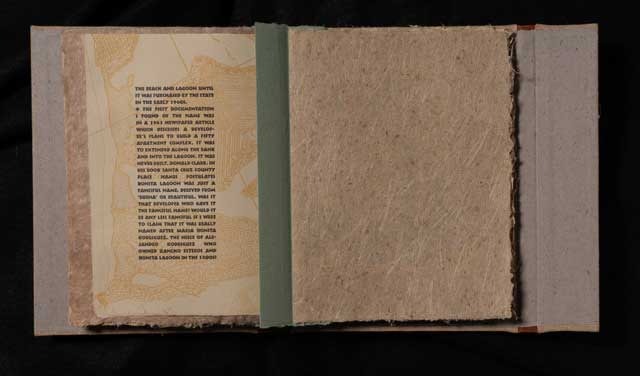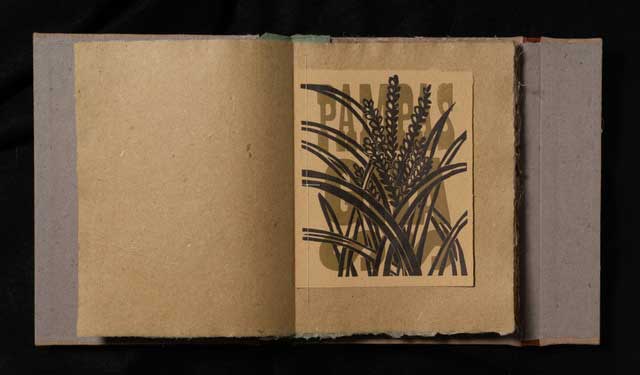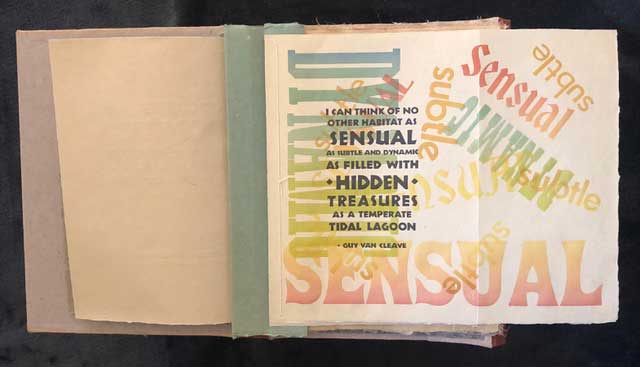PETER & DONNA THOMAS
![]() 260 Fifteenth Avenue Santa Cruz CA 95062 (831)
515-2757
260 Fifteenth Avenue Santa Cruz CA 95062 (831)
515-2757
![]()
Goodbye Bonita Lagoon, A Papermaker’s Elegy. Peter and Donna Thomas, Guy Van Cleave. Santa Cruz, California, Peter and Donna Thomas (2023). 11.75 x 9 x 1.5 inches. 80 pages (this is the total verso/recto count including 12 pages with text and 10 pages with illustrations). 30 copies. An eco-lament, filled with hidden treasures, for what seems to be the possible inevitable loss of the temperate tidal lagoon that sits between our home and the Pacific ocean. Binding: Cloth binding over boards, light green linen cloth with three color linocut print on front cover. Unique tri-fold binding with 2 leather spines, title blind stamped on spine. Endsheets: Brown with plant inclusions, handmade by Peter. Text block: Accordion pleated spine pages stab sewn to folds, 1 inside cover board, title page, introductory text, 8 text pages with 8 plant paper folio samples with illustrated inserts, 2 single sheets. All paper is handmade by Peter and Donna Thomas. Paper: 8 folios and 1 single sheet, made from plants: pampas grass, Kahili ginger, New Zealand flax, wild radish, century plant, bird of paradise, tule, blackberry, and lawn clippings. Text and inserts, made using cotton rag. Accordion spine, made using cotton rag, duplex, green/brown. Inside cover board, made using plant paper scraps, green pigment. Printing: The text is printed using various sizes of Neuland type. The title and introductory pages are printed using metal type and the text pages are digital type on polymer plates. Text behind the illustrations is antique wood type. All type and illustrations were printed on a Vandercook Universal 1, except the inside cover board illustration was printed on a Pearl platen press. Illustrations: Linoleum cuts by Donna Thomas. Notes: The binding structure is our original design, based on the case bound fold out accordion and accordion pleat spine structures we describe in “More Making Books by Hand” (Quarry Books: 2004). The inside cover board provides the viewer with a substantial page to hold as they stretch out the accordion to reveal all the plant papers at once, and the tri-fold binding both protects the foredge and accommodates for the fact that it is thinner than the spine. The 8 plant paper folios each have a single sheet sewn inside. That sheet is printed with a linocut of the plant, the name of the plant having been previously printed using various sizes and styles of wood type. Pages with the text of the book are also sewn to the spine as the verso for each of these folios. The text is printed in black using Neuland type, with an image of the 1853 Coastal Survey map of Santa Cruz - with Bonita Lagoon in the bottom left corner – having been previously printed in light brown. Here is a link to article about the book from our local newspaper: https://lookout.co/santacruz/news/newsletter/2023-05-14/disappearing-bonita-lagoon-fine-art-book-peter-donna-thomas-performative-activism-santa-cruz-county-news-quiz-sunday-reads Photos copyright by Bob Prentiss
Artists' Statement: Through this artwork, book artists Peter and Donna Thomas share a 40-year perspective of living at the edge of Bonita Lagoon. They have seen civic improvements - like cutting and filling hills and valleys to make roads, and culverting or redirecting rivers, streams, and drainages - made it possible for Santa Cruz to grow from a tiny beachside community to a full-fledged city. And they have seen how these alterations to the natural landscapes, water and sand flows have had devastating unintended consequences for tiny Bonita Lagoon and similar coastal ecological habitats, which previously thrived before those changes. Peter and Donna Thomas tell their story through the textures of paper they made from plants growing around the lagoon, through a complex binding structure as diverse as the plant and animal life in the lagoon, and through illustrations that imply the importance of the things that are hidden in and around the more obvious declining Lagoon. Yet this is only a snapshot taken from a human perspective. Bonita Lagoon existed for who knows how many thousands of years before Santa Cruz began to develop around it, causing it to fill with sand, redirecting the flash-floods meant to wash that sand back out to the sea. But geological time is not human time, and at some point a natural event may occur that will again rejuvenate the lagoon. We can only hope we have moved by then. Further description of the project: We started work on this book in 1986 when I learned to make paper from plants from Nida Dumsang, a visiting Filipina papermaker. I decided to make paper from plants growing around the lagoon for a future book project. We have lived next to Bonita Lagoon since 1983. Our unmanicured yard ends in a huge mass of blackberry vines at the edge of the lagoon. The year we moved into our house there was a high tide/high surf/heavy rain event that washed out part of the lagoon's seaward berm and pushed a football field of sand into it. We did a little research and found that the typical lifecycle of a lagoon like ours was that over time it would naturally fill with sand and occasional monumental flash floods would wash the sand out again. We also learned that building the jetty at the Yacht Harbor in the 1960s had caused our downdrift beach to retreat and narrow, exposing the sandstone berm that held water in Bonita Lagoon, making it vulnerable to degradation by heavy surf conditions. We also learned that because of inland changes to natural drainages, the flash-flood flushing will not happen again unless changes to the upstream drainages are made. We decided we might use the plant paper samples to make a book about the history of the lagoon and talk about its ecology and lifespan. Our thought was to make it a neighborhood collaboration with Jim Houston writing the text and Dave McGuire doing the illustrations, but that didn’t work out. Jim was engulfed in research and writing “Snow Mountain Passage.” Dave McGuire was a watercolor painter, and with color digital printing still in its infancy we could not print his paintings with our equipment. We were concurrently working on our, “The History of Papermaking in the Philippines,” which took all of our attention and the Bonita Lagoon book languished. That was until the pandemic. In 2020, as we were preparing samples for “Overruns and Ephemera,” the companion to the Legacy Press bibliography of our work when I rediscovered the plant paper samples and, helped by local history scholars who were likewise homebound by the pandemic lockdown, I started to write the text myself. The Santa Cruz Museum of Art and History allowed us to search their newspaper archives. Norman Potdevin, a local historian of mid-county, showed us his copy of the 1853 Coastal Survey map, (the first survey of the California Coast) showing Bonita Lagoon. The map became the anchor for the design of the book, used as a prompt to remind the viewer that the lagoon existed before Santa Cruz was developed and show how that development has altered the landscape. For our introduction we used excerpts from correspondence with Guy Van Cleave, a wildlife biologist with a special interest in temperate tidal lagoons, to describe the beauty and explain the role small lagoons have in coastal ecosystems. One thing Guy wrote struck us as key: “coastal tidal lagoons are filled with hidden treasures.” We kept that in mind as we explored different ways to integrate the text, map, and plant paper samples, hoping to find a combination that would create a book with equally amazing hidden treasures between the covers. We decided to title it as a papermaker’s elegy, because it is in part an eco-lament for what seems to be the inevitable loss of the tiny lagoon that sits between our home and the ocean. When we moved into our home 40 years ago Bonita was still about three-quarters the size depicted on the 1850 map. Our daughters had a raft and floated in it. Since then, various storm surges have breached the berm and washed in so much sand that now, most summers, it is dry. This demise was caused by modern development. The text ends: Bonita Lagoon has no mechanism to restore itself. Unless someone does something to repair the damage, soon migratory birds will just find sand where they used to feast, and locals will be calling it “Bonita Beach.” This was a very complex book to make. It required using all the skills we have gained from all our previous books and almost every tool we had in the shop. The binding required our leather working and foil stamping skills, as well as the knowledge of how to work with unlined cloth, and how to print a linoleum cut on linen. The text was both hand set and digitally set then printed from polymer plates. It was printed on several different presses, sometimes blending several colors of ink in a press run using colors mixed to specifications using Pantone charts. The paper had to be made to certain requirements, making pulp both from the lagoon’s plants and from used rags, with the most challenging sheet being the cardboard used for the first accordion page. This sheet required using a deckle box and vacuum table, techniques modified from those observed in 1990 in eastern European hand papermills making watermarked paper. We also had to find a way to marry the tragic story of the lagoon with hope. When working with a subject like this, that can be so depressing, we wanted to present an honest description, while at the same time showing ways to see beauty in a changing landscape, and to do that we combined the story about the history of the lagoon with a text Guy Van Cleave wrote about coastal tidal lagoons that is both scientifically accurate and poetic. |
Back to top.
